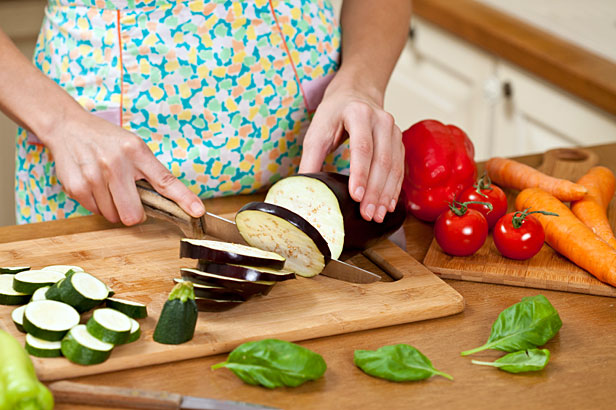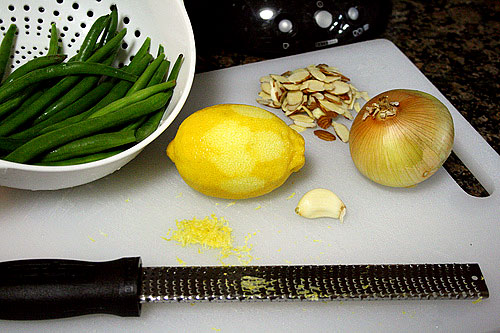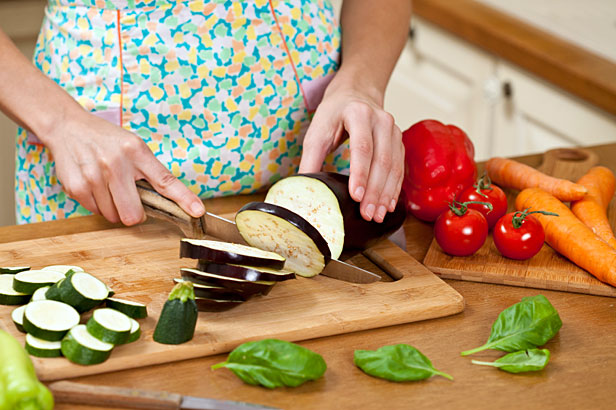 Chop shop: A little advance prep saves lots of time.
Chop shop: A little advance prep saves lots of time.
If you’re like me, summer is chaos: traveling, packing and unpacking, and structureless days. Fall usually brings much-needed order — if I can spend the time to get organized and to regroup.
For me, cooler temperatures also mean a return to cooking. For me, Labor Day is the signal to get the kitchen ready for the season. My goals have been the same for years — I just try to hone in on them more every year. Like Grist’s resident Urbivore Jennifer Prediger, I want to eat out less, and eat more healthful, from-scratch, delicious meals. I want to buy seasonal, local food and waste less of it.
But for this to work with my busy schedule, I need to do all of this with a minimal amount of time and effort. I’m not alone in this struggle — endless headlines and TV shows tell us Americans just can’t find the time to cook for their families, and that’s why they turn to convenience foods and takeout.
Here’s the first way I can save you time: I’ve collected all my tried-and-true shortcuts for getting healthy food on the table, below:
1. Organize, organize, organize
Nothing slows cooking down like not being able to find the tools that you need to get the job done.
- Clean out the refrigerator, the freezer, the pantry, and your spices regularly.
- If you put up summer produce in the freezer or in jars in your pantry, make sure you know what you have and plan to use it.
- Remember that you won’t use what you can’t see. For that reason, invest in clear glass containers for storing food in the refrigerator, and for extra credit, use masking tape and a permanent marker to label them with the contents and the date it was made or prepped.
- Organize your tools and utensils by how and where you do most of cooking. I like to keep my most used utensils and spices right beside the stove so they are easily at reach when I am cooking.
- Keep your countertops clear and your kitchen clean. If your countertop is cluttered, your refrigerator overcrowded, or your sink full of dirty dishes; you’re less likely to cook. Even if you do, you’ll be wasting a lot of time cleaning up and looking for things.
 Zest for life: A microplane comes in handy a lot.(Photo courtesy of ccharmon via Flickr)2. Invest in a few good tools
Zest for life: A microplane comes in handy a lot.(Photo courtesy of ccharmon via Flickr)2. Invest in a few good tools
There’s not much that you can’t cook with a good, sharp chef’s knife and a good-size cutting board. (I find that many people have these tiny cutting boards — great for quartering a lemon, but inadequate for making dinner.) There are a few additional small tools that I use on a daily basis that really speed things up in the kitchen and produce great results.
- Microplaner: I keep mine right beside the stove, where I use it for grating lemon peel, cheese, garlic, nutmeg, and other spices.
- Large mortar and pestle: I use mine to make pesto and other herb purees, to coarsely grind fresh toasted spices, to make guacamole, to smash garlic with a little salt before making garlic mayo or other garlicky sauces.
- Mandolin: These devices do require a good bit of caution to use without nicking your fingertips, but they make slicing cucumbers, mushrooms, potatoes, carrots, etc. thinly and uniformly a snap. While French mandolins tend to be ridiculously expensive and complicated, the economical and small Japanese mandolins can be found in most Asian markets for under $20.
- Handheld immersion blender: I use mine to puree winter squash or other creamy vegetable soups right in the soup pot. I also use it regularly for making yogurt and fresh fruit smoothies. Avoid the models with lots of extra attachments, they aren’t worth the expense.
3. Have a plan, and learn the art of food prep
Thinking ahead makes a big difference in the quality of food that I eat. I like to set aside about an hour and a half after a trip to the farmers market to prep food for up to a week of quick, easy, delicious meals and snacks.
Last Saturday, I was vacationing at the beach with my family. I came back from the market with a wealth of produce: green and wax beans, peaches, plums, broccoli, butternut squash, watermelon, tomatoes, cucumbers, corn, two heads of romaine, a variety of eggplants, summer squash, sweet red and yellow peppers, sweet onions, red onions, and lots of fresh herbs. The first thing I did was make a list of what to do with all the produce. I was planning to feed eight adults and children for a week, as well so it might look intimidating, but you’ll at least see the process. It looked something like this:
First, the week’s menu: Crudites with yogurt-herb dip, grilled vegetables and corn on the cob (to be served with grilled chicken), quinoa salad with roasted broccoli and winter squash, tomato and watermelon salad (see my savory Fourth of July salads post), fresh corn salad, bean salad, baba ghanoush, marinated pepper salad, simple cucumber salad, faro salad with grilled vegetables, and peach & plum crisp.
After the plan was in place, I enlisted my husband to help with washing, peeling, and chopping. In the restaurant world, we call this step of getting everything ready by the French term, mise en place, which translates literally as “everything in place.” It is a tremendously useful process for making cooking a manageable, quick, and low-stress task.
Our tasks:
- Trim and blanch green and wax beans — some for salad, some for crudites with yogurt-herb dip.
- Roast half of the broccoli and butternut, and mix with cooked quinoa, thinly sliced red onion, vinaigrette, and herbs for salad.
- Blanch remaining broccoli in the same water used for blanching green beans and use for crudites with yogurt-herb dip.
- Chunk watermelon and tomatoes for salad; dice a small tomato for fresh corn salad; cut remaining watermelon into chunks for snacking.
- Cut cucumbers into batons for crudites/dipping, dice some cucumber for adding to corn salad, slice four to five cucumbers into thin rounds for cucumber salad.
- Prep eight ears of corn for the grill by removing corn silks (but not husks!); cut corn off six ears for fresh corn salad.
- Wash and salad-spin two heads of romaine; place in a lettuce bag.
- Slice two large eggplant, four summer squash, and three sweet onions into 3/4-inch thick slices for grilling; reserve two more eggplant for grilling/charring whole. (The grilled eggplant will get mashed with salt, garlic, tahini and lemon juice for baba ghanoush.)
- Slice two red or yellow peppers into strips for crudites/dipping, dice one for corn salad, and reserve four to five more for the grill. (They’ll get mixed with fresh garlic, salt, pepper, parsley, and red wine vinaigrette for marinated sweet pepper salad.)
- Cut two red onions in half from root to tip; slice three halves very thinly for quinoa salad, watermelon salad, and cucumber salad; dice the fourth half for adding to c
orn salad. - Chop a whole head of garlic.
- Make herbed-yogurt dip for crudites and for a sauce for grilled eggplant.
- Make red-wine vinaigrette.
- Cook 1 cup faro and toss with 2 teaspoons of vinaigrette and fresh herbs to have ready for leftover grilled vegetables.
- Make oat-crisp topping and freeze to have ready for impromptu fresh fruit desserts
With his help washing, chopping and peeling for 45 minutes, I finished my list in less than two hours — and for the rest of the week we had fresh vegetables and salads at our fingertips, which greatly cut down on the prep for each individual meal.
4. Always eke out two (or three) meals from one
I rarely prepare from-scratch meals one at a time, especially if I am cooking for just me or the two of us. That’s very inefficient both from a labor and energy perspective.
- If I make soup, I make a large enough batch that half can go in the freezer for next week — ditto for tomato sauce, chili, and pesto. I will often portion soups into 2-cup containers for freezing: the perfect healthy grab-and-go lunch. Cooked oatmeal also freezes well for quick breakfasts.
- If I make a pot of beans, some become soup, some become bean salad, and some become dip or a topping for crostini.
- If we fire up the grill, I always grill two or three times what we will eat that night. Grilled vegetables get chopped and mixed with quinoa or faro for salads; I’ll even throw on a couple of whole eggplant and peppers to char for baba ghanoush and marinated roasted red peppers; leftover grilled chicken becomes chicken salad or tacos, leftover grilled fish gets mixed with egg, onion, herbs, and breadcrumbs to become tomorrow’s fish cakes.
- Also, if I use my oven, I feel like I have to fill it up to save both time and energy. If I bring a pot of water to a boil to blanch green beans, I’ll go ahead and blanch greens, broccoli, or boil potatoes all in the same water, successively. I might even save that vegetable blanching water to use as broth for soup.
5. Learn a few good sauces or condiments by heart
I’ve found that you can eat very, very simply and still tantalize your taste buds by relying on a few good sauces for variety. In addition to the yogurt-herb dip and a good sharp vinaigrette mentioned above, I constantly rely on homemade mayo, homemade salsas, and kimchi. You can vary all of these sauces infinitely to suit your needs, your taste, and to a large extent the ingredients you have on hand.
6. Practice self-preservation
Spending time “putting up” fresh produce in the summer buys you time later, especially if you’re smart about what you put up in the first place. Instead of putting up whole canned tomatoes, why not cook those tomatoes down into your favorite tomato sauce or into flavor-packed roasted tomatoes? You’ll be one step closer to getting dinner on the table.
Got any additional labor-, time-, and/or energy-saving kitchen? Share them with us in the comments section!
Next: Recipes for Basic Vinaigrette, Herbed Yogurt Dip, Cucumber and Corn Salads
Basic Vinaigrette
1 part vinegar or lemon or lime juice
3 parts olive oil (or other vegetable or nut oil)
Salt and pepper to taste
Optional: add a bit of finely diced shallot or garlic and a dab of Dijon or coarse mustard
Whisk all ingredients together until well blended. Taste for seasoning. Use right away or store tightly covered in the refrigerator for up to 1 week.
Other possible additions — chopped olives or capers, chopped fresh or sundried tomatoes, herbs or spices, honey, sugar or molasses.
Herbed Yogurt Dip
1 cup plain yogurt (use your favorite)
1 tablespoon chopped shallot or 1/2 teaspoon finely chopped garlic
2 tablespoons finely chopped herbs (I used dill and chives, but also try parsley, basil, scallions, and fresh thyme)
1/2 teaspoon fresh ground pepper
1/2 teaspoon salt
Stir all ingredients together and store in the refrigerator for up to 1 week.
Simplest Cucumber Salad
4 to 5 small cucumbers (or substitute 2 medium cucumbers), peeled only if the peel tastes bitter
1/2 onion, thinly sliced
1/2 teaspoon salt
Pinch of sugar (optional)
1 tablespoon of vinegar
Toss all ingredients well to combine. Refrigerate for up to a week.
Other possible additions — a pinch of celery seeds; yogurt and fresh dill; minced hot peppers and mint
My Mom’s Fresh Corn Salad (Last of the Summer)
5 to 6 ears of corn, shucked and corn cut off the cob
1/2 red onion, chopped
1 small tomato, chopped
1 small cucumber, chopped
1/2 red pepper, chopped
1/2 teaspoon salt
1/2 teaspoon black pepper
1 teaspoon cider vinegar
1 tablespoon extra virgin olive oil
1 tablespoon mayo (preferably homemade) or sour cream
A small handful of torn fresh basil
Combine all the ingredients, mixing well to combine. Refrigerate for up to a week.


